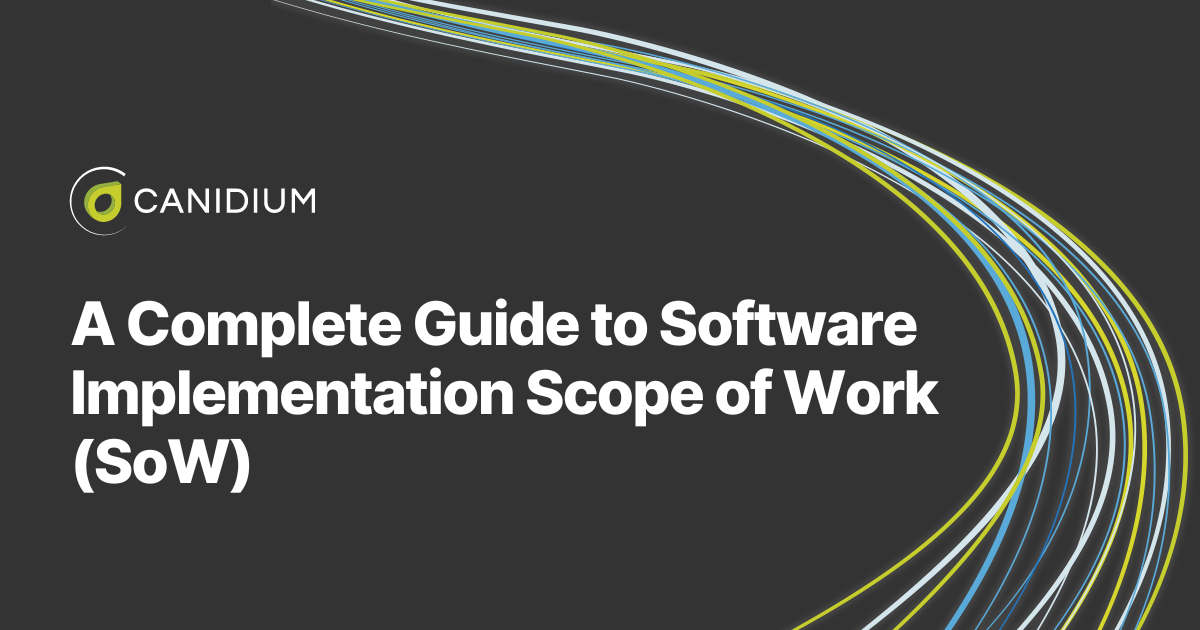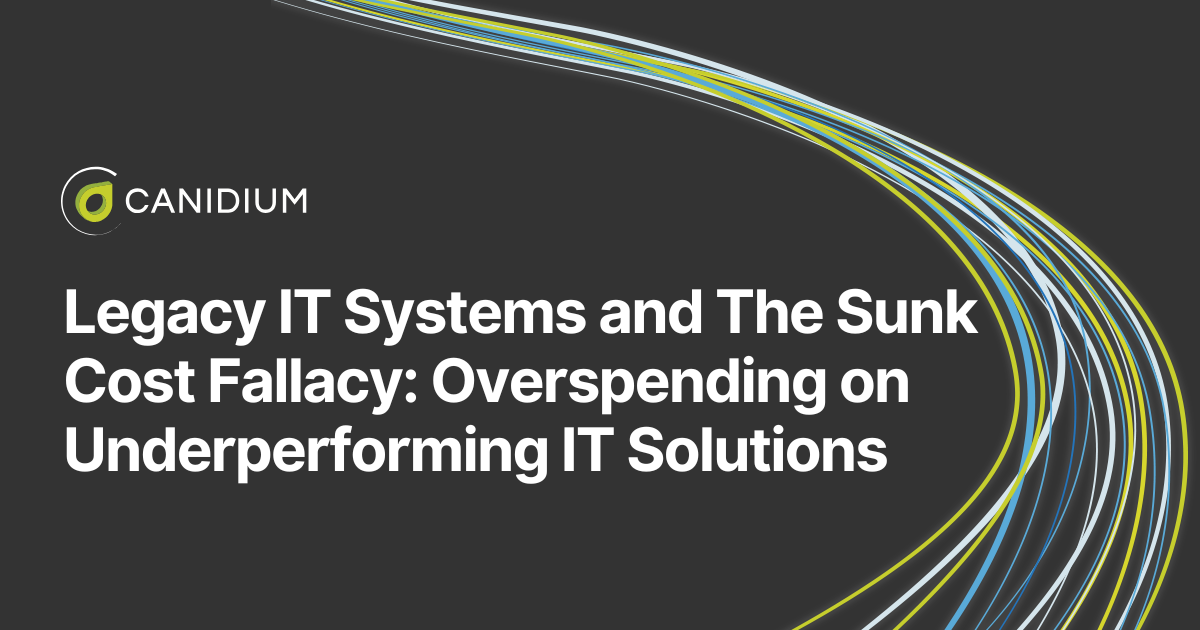Completing the scope of work (SoW) process with an implementation partner is a lengthy process. It requires time and resources that can seem daunting to any organization. As time-consuming as it is, we suggest going through each step meticulously. A software implementation scope of work (SoW) document that serves as a comprehensive blueprint that guides your project from inception to completion. If not done well, it can make for a chaotic and possibly unsuccessful implementation.
Using our experience creating thousands of SoWs, we have put together a comprehensive guide on the subject so that you can go into the process fully informed and ready to proceed efficiently. No matter which implementation partner you choose, we want you to be armed with the right expectations, so you can succeed.
Want to download this information instead?
This article will explore:
- The essential components typically found in an SoW
- How they contribute to successful software implementation
- Best practices for organizations beginning the SoW process
- What follow-up questions to ask
Components of a comprehensive SoW
Project Overview
Brief description of the project's purpose and goals.
Every journey begins with a destination in mind. The project overview section of the SoW paints a clear picture of why your software implementation project exists and what it seeks to achieve. The compass ensures that everyone involved is headed in the right direction.
Scope Description
Detailed explanation of the software's functionality and features.
The scope description is where the project's heart is revealed. It outlines the software's functionality and features meticulously, providing a comprehensive view of the end product. This section sets the stage for development, leaving no room for ambiguity.
Project Objectives
A clear statement of what the project aims to achieve.
The project's objectives are the guiding stars that steer your project toward success. They provide a crystal-clear understanding of what the project strives to accomplish. These objectives serve as a litmus test for all actions and decisions throughout the project's lifecycle.
Project Deliverables
List of all the tangible items or outcomes expected from the project.
Tangible outcomes are the markers of progress. In this section, you enumerate the specific deliverables - software components, documentation, or milestones - that will emerge from your project. These deliverables give everyone involved a tangible sense of achievement.
Project Schedule
Timeline outlining project phases, milestones, and deadlines.
Time is a precious commodity in any project. The project schedule in the SoW is a meticulously crafted timeline that breaks down the project into phases, milestones, and deadlines. It keeps the project on track and helps prevent time-related bottlenecks.
Resource Requirements
Specify the personnel, hardware, software, and other resources needed.
Turning vision into reality requires the right help. In this section, you clearly outline the personnel, technology, hardware, software, and other resources essential for the project's success. This ensures that nothing is left to chance when it comes to resourcing.
Roles and Responsibilities
Define the roles and responsibilities of team members and stakeholders.
Every project is a team effort, and clarity in roles and responsibilities is essential. The SoW identifies who is responsible for what, from team members to stakeholders. This fosters a harmonious and efficient work environment.
Project Assumptions
Document any assumptions made during project planning.
Assumptions can be the hidden obstacles in your project's path. In this section, you document any assumptions made during project planning, ensuring that they are transparent and subject to scrutiny.
Risk Assessment
Identification of potential risks and mitigation strategies.
Risk is a constant companion in software development. The SoW's risk assessment section identifies potential risks and outlines strategies to mitigate or address them. This proactive approach enhances the project's resilience.
Change Control Process
Outline how changes to the scope will be managed and approved.
Change is inevitable, and how you manage it can be the difference between success and chaos. The SoW defines a structured process for managing and approving project scope changes, ensuring they don't derail progress.
Quality Assurance and Testing
Describe the testing process and quality assurance measures.
Quality is non-negotiable in software development. The SoW's quality assurance and testing section elucidates how your project will ensure that the software meets the highest standards, ensuring reliability and user satisfaction.
Acceptance Criteria
Define the criteria that must be met for the project to be considered complete.
Completion is the ultimate destination, and it must be defined clearly. The SoW specifies the criteria that the software must meet before it's considered complete and ready for deployment, leaving no room for ambiguity.
Communication Plan
Specify how communication will be handled among team members and stakeholders.
Effective communication is the lifeblood of a successful project. The SoW's communication plan section outlines how communication will be orchestrated among team members and stakeholders, fostering transparency and alignment.
Budget and Cost Estimate
Provide an estimate of project costs and budget constraints.
Money matters, and the SoW doesn't shy away from it. This section estimates the project's costs and sets budget constraints to ensure fiscal responsibility.
Legal and Compliance Considerations
Address any legal or regulatory requirements that need to be met.
The legal landscape can be treacherous, and compliance is paramount. The SoW navigates this terrain, addressing any legal or regulatory requirements the project must adhere to, safeguarding against legal pitfalls.
Training and Documentation
Describe any training that will be provided and document requirements.
Knowledge transfer is vital for long-term success. The SoW details any training that will be provided and outlines documentation requirements for the project's future.
Post-Implementation Support
Detail the support and maintenance plan after the software is deployed.
Launching the software is just the beginning of the journey. The post-implementation support section outlines the ongoing maintenance and support plan, ensuring the software's longevity.
Dependencies
List any external factors or dependencies that may impact the project.
In the intricate web of dependencies, foresight is invaluable. The SoW itemizes any external factors or dependencies that might influence the project's progress, allowing for proactive management.
Approval and Sign-Off
Define the process for project approval and sign-off.
Every project needs a formal conclusion. The SoW establishes the project approval and sign-off process, ensuring that all stakeholders are aligned and satisfied with the project's outcomes.
Appendices
Include any additional documents or reference materials as needed.
Sometimes, the devil is in the details. The appendices section of the SoW allows for the inclusion of supplementary documents and reference materials for further context.
Importance of a Thorough Statement of Work (SoW)
A Statement of Work (SoW) is not merely a document; it's a blueprint for success in any software implementation project. It lays the foundation, sets the direction, and aligns all stakeholders towards a common objective. Imagine embarking on a journey without a map or destination; chaos would ensue. Similarly, a project without a clear and thorough SoW is prone to confusion, misalignment, and failure.
A Statement of Work (SoW) is the cornerstone of any successful software implementation project. It serves as a roadmap, guiding all stakeholders towards a common goal. Here's why a thorough SoW is essential:
Clarity and Alignment
The SoW provides a clear and detailed description of the project's purpose, goals, and scope. It ensures that everyone involved is on the same page, reducing misunderstandings and disagreements down the line.
Risk Mitigation
By outlining potential risks and mitigation strategies, the SoW helps project teams identify and address issues before they escalate. This proactive approach enhances the project's resilience and minimizes the likelihood of costly delays.
Resource Management
The SoW specifies the personnel, hardware, software, and other resources needed for the project. This ensures that resources are allocated efficiently and that nothing is overlooked regarding resourcing.
Communication and Transparency
A well-defined communication plan in the SoW ensures that communication among team members and stakeholders is handled effectively. This fosters transparency and alignment, leading to smoother project execution.
Quality Assurance
The SoW's quality assurance and testing section describes how the project will ensure that the software meets the highest standards. This is crucial for ensuring reliability and user satisfaction.
Change Management
The SoW's change control process outlines how changes to the scope will be managed and approved. This helps prevent scope creep and ensures that changes are implemented in a structured manner.
Budget Control
The SoW is a crucial document that ensures fiscal responsibility by setting project costs and budget constraints. This helps to keep the project financially on track, avoiding unexpected expenses or overruns.
Legal and Compliance
The SoW is a detailed document that outlines legal and regulatory requirements to ensure compliance and prevent legal issues. It covers permits, licenses, certifications, and other statutory obligations. It helps stakeholders understand their roles and responsibilities and avoid legal pitfalls.
Best Practices for Organizations Starting the SoW Process
Embarking on a software implementation project is a significant undertaking, and choosing the right implementation partner can make all the difference. However, selecting a partner is just the beginning; establishing a successful partnership requires careful planning and execution. Here are some best practices for organizations reaching out to a software implementation partner:
Clearly Define Your Requirements
Defining your requirements is the first step toward a successful software implementation project. By providing a detailed description of your project's purpose, goals, and scope, you are setting the stage for a collaborative and effective partnership with your implementation partner. This clarity not only helps the partner understand your needs but also allows them to tailor their approach and solutions to meet your specific requirements. It ensures that both parties are aligned, leading to a more efficient and successful project execution. Effective communication and clear expectations are key to a fruitful partnership and project outcome.
Research Potential Partners
When researching potential implementation partners, you must investigate their expertise and experience to ensure they align with your project needs. Look for partners with a proven track record of success in similar projects, showcasing their ability to deliver results and meet expectations. By conducting thorough research and selecting partners with a strong history of achievement, you can enhance the likelihood of a successful and fruitful collaboration. Remember, the right partner can make all the difference in the outcome of your software implementation project.
Communicate Clearly and Effectively
Consistent and effective communication is the backbone of any successful partnership, especially regarding software implementation projects. Maintaining open and transparent communication with your implementation partner throughout the project lifecycle is essential. You create a foundation of trust and collaboration by clearly articulating your expectations, timelines, and any changes to the scope. This level of communication ensures everyone is on the same page, mitigates misunderstandings, and allows for timely adjustments. Remember, communication is not just about conveying information; it's about building a strong and cohesive team that is aligned to achieve the project's goals. So, keep the lines of communication open, be proactive in sharing updates and feedback, and work together to navigate any challenges.
Establish a Governance Structure
Establishing a clear governance structure is essential for the success of any software implementation project. By defining roles and responsibilities for your organization and the implementation partner, you create a framework that promotes accountability and streamlines decision-making processes. This structured approach ensures that everyone, from key stakeholders to team members, knows their role in the project and facilitates effective communication and collaboration. With a well-defined governance structure, you can navigate challenges, resolve issues, and make informed decisions that propel the project toward its ultimate completion.
Set Realistic Expectations
Be realistic about your project's timeline and budget. Set achievable goals and milestones to keep the project on track. By setting realistic expectations, you are laying a solid foundation for success. This approach helps manage stakeholders' expectations, ensuring that the project stays on course and is completed within the agreed-upon timeframe and budget constraints. Clear communication regarding timelines and budget allocations is key to avoiding surprises and maintaining transparency throughout the project. Remember, staying mindful of these factors will contribute to smoother project execution and ultimately lead to a successful outcome.
Monitor Progress Closely
Stay actively involved in the project and monitor progress closely. Addressing any issues or concerns promptly is crucial to prevent them from escalating into major roadblocks. By staying vigilant and proactive in problem-solving, you can maintain the project's momentum and swiftly resolve any hiccups. This hands-on approach demonstrates your commitment to the project's success and fosters a culture of accountability and responsiveness within the team. Effective project management requires constant monitoring and timely intervention to keep things on track and deliver results efficiently. So, stay engaged, stay alert, and stay ahead of any potential challenges.
Provide Feedback
Effective communication is a two-way street, and providing regular feedback to your implementation partner is key to fostering a collaborative and productive relationship. By sharing your thoughts on what is working well and where improvements can be made, you help them understand your expectations and empower them to make necessary adjustments to keep the project on course. This open feedback loop creates a culture of continuous improvement, where both parties can work together to overcome challenges and optimize project outcomes. Remember, feedback is a valuable tool for driving success and ensuring the project stays aligned with its goals and objectives. So, don't hesitate to share your insights and observations with your implementation partner throughout the project lifecycle.
By following these best practices, organizations can establish a strong foundation for a successful partnership with their software implementation partner, ultimately leading to a successful project outcome. Clear communication, realistic expectations, active monitoring, and open feedback are key elements in fostering a collaborative and productive relationship. This proactive approach not only ensures that the project stays on track but also promotes a culture of continuous improvement and mutual understanding. By adhering to these best practices, organizations can navigate challenges effectively, optimize project outcomes, and achieve their goals efficiently. Remember, a successful partnership is built on trust, communication, and a shared commitment to excellence in software implementation.
Download the complete SoW Interview Guide
Photo by Kindel Media








